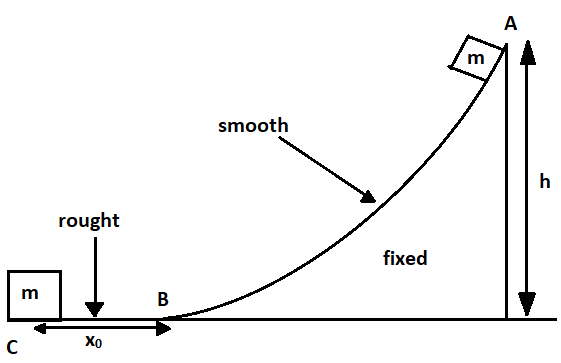
Work done by normal reaction is zero during the motion of the block:

A) From point A to B only
B) From point B to C only
C) From A to C
D) None of these
Answer
124.2k+ views
Hint: In order to solve this question you have to remember the concepts of the work-energy theorem and the use of force for finding work done. The work-energy theorem states that the work done by all the forces that are acting on a particle will be equal to the change in the kinetic energy of that particle.
Complete step by step solution:
In the question, it is given a small block of mass m, which is released from point A on a fixed smooth wedge as shown in the above figure. The top of the wedge is marked as A and the bottom as B and at point C the block stops moving because of the roughness of the floor.
We have to find the portion where the work done by the normal reaction is zero during the motion of the block
We already know that the normal reaction is always perpendicular to the direction of motion.
So, it means that the work done by the normal reaction is equal to zero from point A to C as the normal reaction is perpendicular to the displacement of the block.
Hence, from the above discussion, it is clear that the work done by the normal reaction is zero during the motion of the block will be from point A to C.
Therefore, the correct option is (C).
Note: Always keep in mind that the normal reaction is the force that is applied by the surface in reaction to the weight that the object exerts on the surface. The normal reaction force is perpendicular to the surface that an object contacts. For example, the table surface that prevents an object from falling from the table.
Complete step by step solution:
In the question, it is given a small block of mass m, which is released from point A on a fixed smooth wedge as shown in the above figure. The top of the wedge is marked as A and the bottom as B and at point C the block stops moving because of the roughness of the floor.
We have to find the portion where the work done by the normal reaction is zero during the motion of the block
We already know that the normal reaction is always perpendicular to the direction of motion.
So, it means that the work done by the normal reaction is equal to zero from point A to C as the normal reaction is perpendicular to the displacement of the block.
Hence, from the above discussion, it is clear that the work done by the normal reaction is zero during the motion of the block will be from point A to C.
Therefore, the correct option is (C).
Note: Always keep in mind that the normal reaction is the force that is applied by the surface in reaction to the weight that the object exerts on the surface. The normal reaction force is perpendicular to the surface that an object contacts. For example, the table surface that prevents an object from falling from the table.
Recently Updated Pages
Difference Between Circuit Switching and Packet Switching

Difference Between Mass and Weight

JEE Main Participating Colleges 2024 - A Complete List of Top Colleges

JEE Main Maths Paper Pattern 2025 – Marking, Sections & Tips

Sign up for JEE Main 2025 Live Classes - Vedantu

JEE Main 2025 Helpline Numbers - Center Contact, Phone Number, Address

Trending doubts
JEE Main 2025 Session 2: Application Form (Out), Exam Dates (Released), Eligibility & More

Class 11 JEE Main Physics Mock Test 2025

JEE Main Exam Marking Scheme: Detailed Breakdown of Marks and Negative Marking

JEE Main 2023 January 24 Shift 2 Question Paper with Answer Keys & Solutions

Learn About Angle Of Deviation In Prism: JEE Main Physics 2025

JEE Main 2025: Conversion of Galvanometer Into Ammeter And Voltmeter in Physics

Other Pages
JEE Advanced Marks vs Ranks 2025: Understanding Category-wise Qualifying Marks and Previous Year Cut-offs

NCERT Solutions for Class 11 Physics Chapter 1 Units and Measurements

NCERT Solutions for Class 11 Physics Chapter 9 Mechanical Properties of Fluids

Units and Measurements Class 11 Notes: CBSE Physics Chapter 1

NCERT Solutions for Class 11 Physics Chapter 2 Motion In A Straight Line

NCERT Solutions for Class 11 Physics Chapter 7 Gravitation




